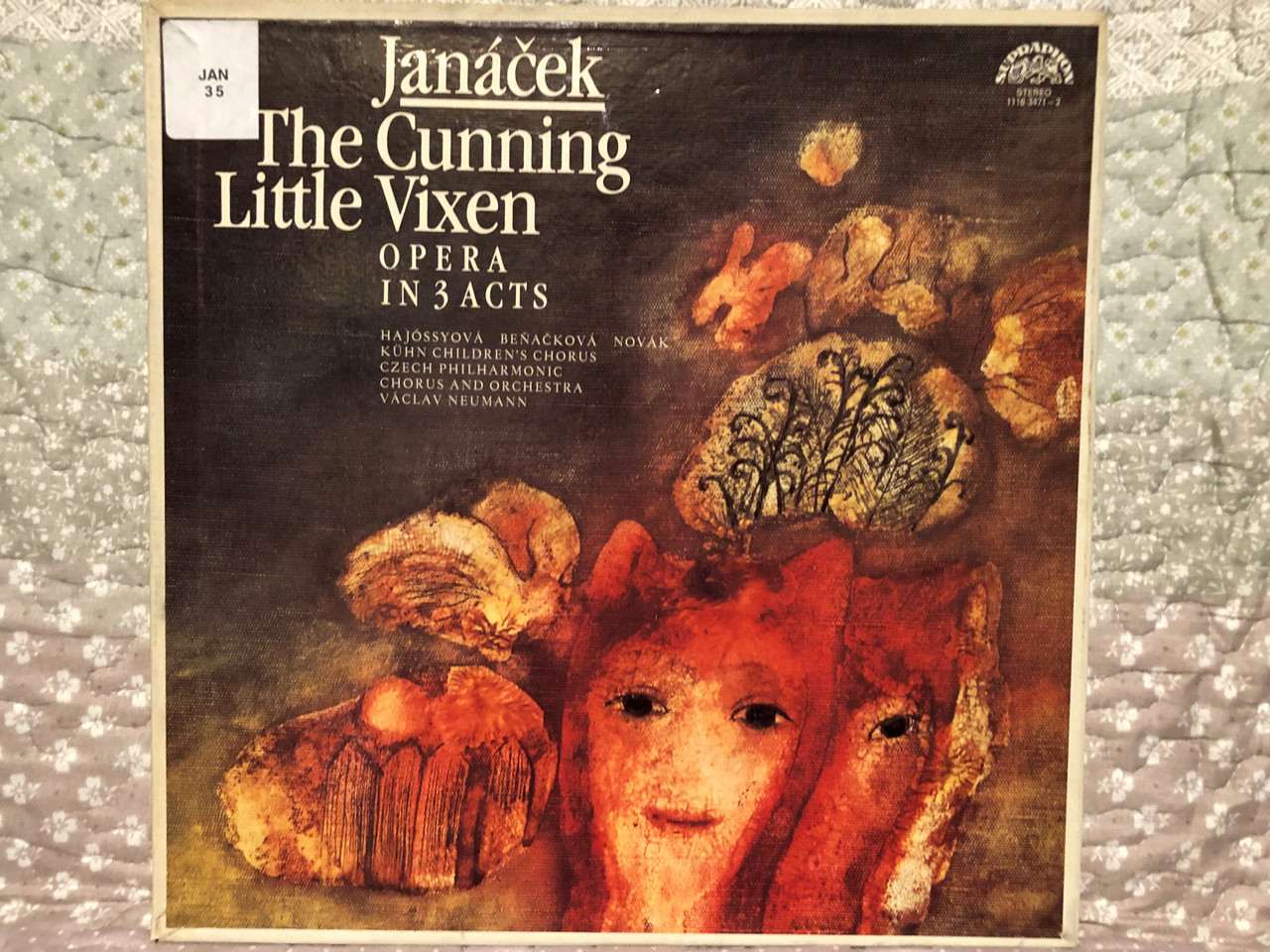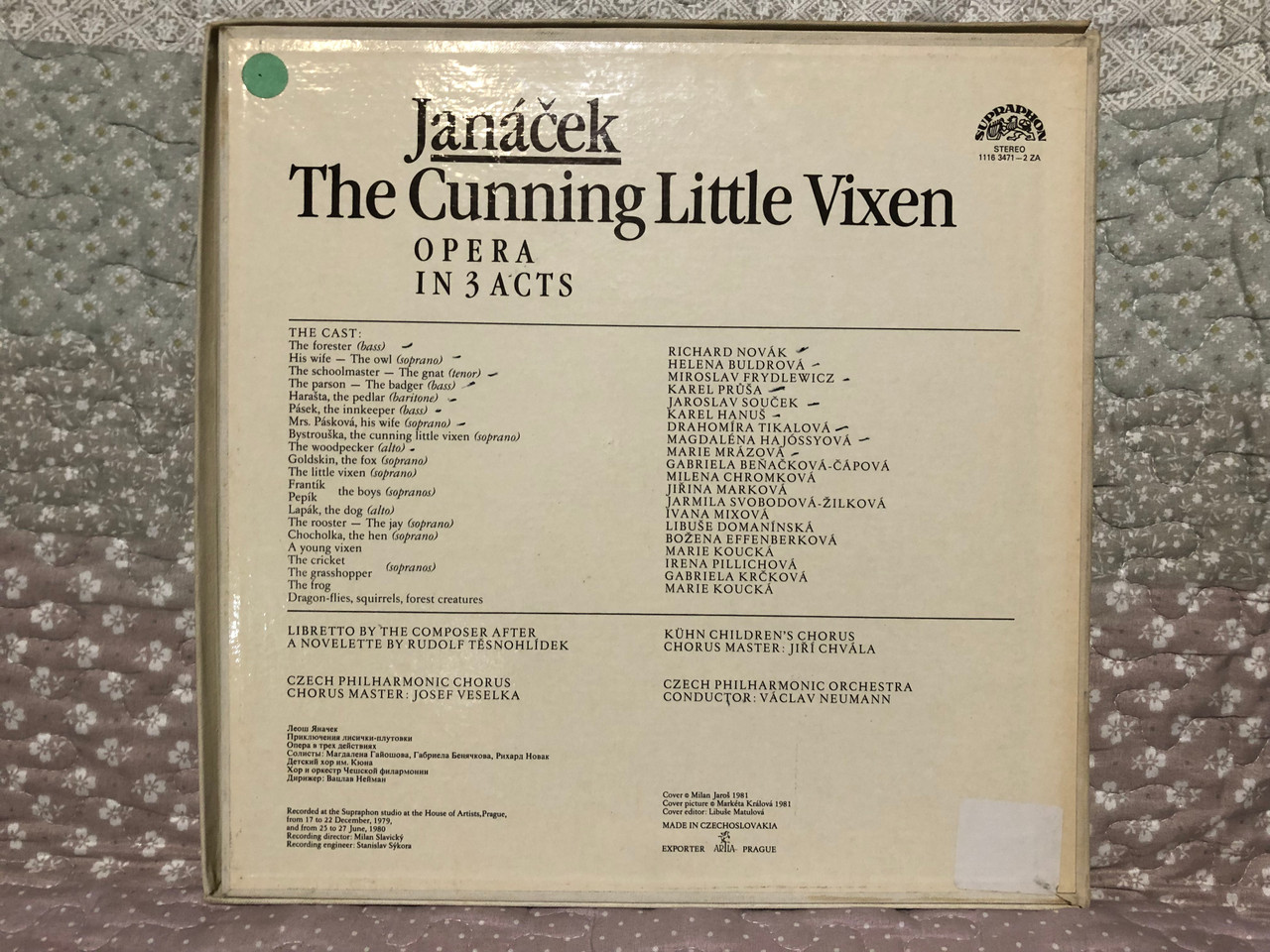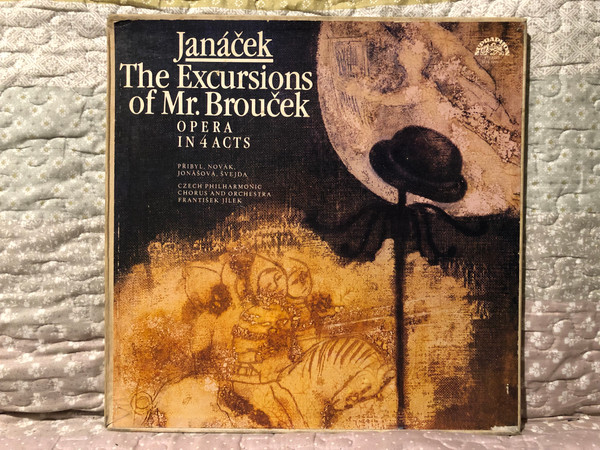Description
Janáček: The Cunning Little Vixen (Opera in 3 Acts) - Hajóssyová, Beňačková, Novák, Kuhn Children's Chorus, Czech Philharmonic Chorus and Orchestra, Václav Neumann / Supraphon 2x LP, Stereo
1116 3471–72 ZA
| Label: | Supraphon – 1116 3471–72 |
|---|---|
| Format: |
2 x Vinyl, LP, Album, Stereo
|
| Country: | Czechoslovakia |
| Released: | |
| Genre: | Classical |
| Style: | Opera, Modern |
Tracklist:
| Příhody Lišky Bystroušky (Opera O 3 Dějstvích) | |||
| A | 1. Dějství | ||
| B | 2. Dějství | ||
| C1 | 2. Dějství (Dokončení) | ||
| C2 | 3. Dějství | ||
| D | 3. Dějství (Dokončení) |
- Choir – Pražský Filharmonický Sbor, Kühnův Dětský Sbor
- Chorus Master – Jiří Chvála, Josef Veselka
- Composed By, Libretto By – Leoš Janáček
- Conductor – Václav Neumann
- Design – Milan Jaroš
- Engineer – Stanislav Sýkora
- Layout – Miloš Pokora
- Liner Notes – Dr. Milena Černohorská
- Orchestra – Českà Filharmonie
- Photography By – Markéta Králová, Oto Dlabola, Pavel Horník
- Producer – Dr. Milan Slavický
- Vocals – Božena Effenberková, Drahomíra Tikalová, Gabriela Beňačková-Čápová, Gabriela Krčková, Helena Buldrová, Irena Pillichová, Ivana Mixová, Jarmila Svobodová-Žilková, Jaroslav Souček, Jiřina Marková, Karel Hanuš, Karel Průša, Libuše Domanínská, Magdaléna Hajóssyová, Marie Koucká, Marie Mrázová, Milena Chromková, Miroslav Frydlewicz, Richard Novák
The Cunning Little Vixen (original title Příhody lišky Bystroušky or Tales of Vixen Sharp-Ears in English), is a three-act Czech-language opera by Leoš Janáček completed in 1923 to a libretto the composer himself adapted from a novella by Rudolf Těsnohlídek.
Name
The opera's libretto was adapted by the composer from a 1920 serialized novella, Liška Bystrouška, by Rudolf Těsnohlídek, which was first published in the newspaper Lidové noviny (with illustrations by Stanislav Lolek). For the title of the opera, Příhody means tales; lišky is the genitive of vixen. Bystroušky, still genitive, is the pun sharp, having the double meaning of pointed, like fox ears, and clever. The opera first became familiar outside Czechoslovakia in a 1927 German adaptation by Max Brod who provided the new name Das schlaue Füchslein, by which Germans still know it and which in English means The Cunning Little Vixen.
Composition
When Janáček discovered Těsnohlídek's comic-strip-inspired story and decided to turn it into an opera, in 1921, he began work by meeting with the author and studying the animals. With this understanding of the characters involved, his own 70 years of life experience, and an undying, unrequited love for the much younger, married Kamila Stösslová, he began work on the opera. He transformed the originally comedic cartoon into a philosophical reflection on the cycle of life by ending with the death of the titular Vixen; as with other operas by elderly composers, this one depicts life leading to a return to simplicity. Work was completed in 1922-23 and the first edition was published the next year in Vienna by Universal Edition. The premiere took place on 6 November 1924 in National Theatre Brno conducted by František Neumann, with Ota Zítek as director and Eduard Milén as stage designer.
The opera incorporates Moravian folk music and rhythms as it recounts the life of a clever (alternative reading: sharp-eared) fox and accompanying wildlife, as well as a few humans, and their small adventures while traversing their lifecycles. Described as a comic opera, it has nonetheless been noted to contain a serious theme. Interpretations of the work remain varied, ranging from children's entertainment to tragedy.
Performance history
The first non-Czech performance took place in Mainz, Germany, in 1927 in an adaptation by Max Brod under the title Das schlaue Füchslein. Brod described the opera as a "dream of the eternity of nature and love-lust", but his version substantially changed the story-line. It was not successful. In 1956 Walter Felsenstein created a performing version closer to the original, which was successfully performed at the Komische Oper in Berlin. In 1965, Felsenstein made this a Deutscher Fernsehfunk movie with Irmgard Arnold in the title role, but retaining Brod's Das schlaue Füchslein title.
The opera received its Italian premiere at La Scala in 1958 with Mariella Adani in the title role. The work was first staged in England in 1961 by the Sadler's Wells Opera Company (now the English National Opera) with June Bronhill in the title, albeit with a tenor Fox (Kevin Miller); the director was Colin Graham, with conductor Colin Davis, and scenery and costume designs by Barry Kay. A production by David Pountney was mounted by the three UK national companies in the 1980s, first being seen with Scottish Opera at the 1980 Edinburgh Festival, then Welsh National Opera in London the following year and finally with English National Opera in June 1988; nearly 40 years on Pountney supervised a revival by Welsh National Opera in Cardiff and on tour. In 1981, the New York City Opera mounted a production in English based on images created by Maurice Sendak and conducted by Michael Tilson Thomas in his company debut. It starred soprano Gianna Rolandi as Vixen Sharp-Ears and baritone Richard Cross as the Forester. Glyndebourne Festival Opera staged it in 2012, directed by Melly Still, and a revival was included in the Glyndebourne Festival for 2016 with Christopher Purves as the Forester and Elena Tsallagova as the Vixen, conductor Jakub Hrůša and the London Philharmonic Orchestra. In May 2014 the Cleveland Orchestra, conducted by Franz Welser-Möst, performed an innovative version directed by Yuval Sharon. This production returned the opera to its roots by utilizing animation and hand drawn video sets by the artists Bill Barminski and Christopher Louie of Walter Robot Studios. The production featured the use of hole-in-the-wall carnival cutouts to place the singers' heads on the animated bodies of the animal characters.
BOX #15

































